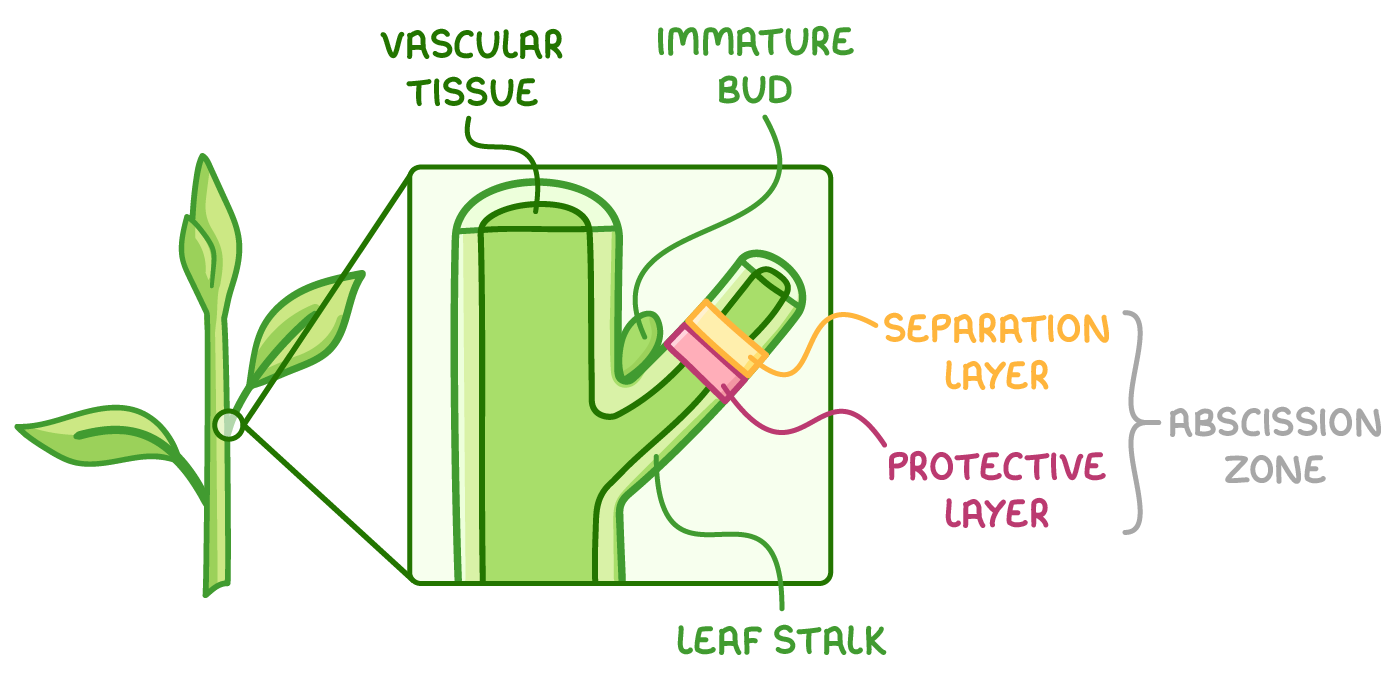Plant Responses to Abiotic Stress
This lesson covers:
- Plant sensitivity to light and dark periods
- The leaf abscission process
- How plants prevent cellular freezing
- The role of ABA in stomatal regulation
Abiotic stresses in plants
Abiotic stresses are non-living factors in the environment that can negatively affect an organisms survival.
In plants, some abiotic stresses include:
- Changes in day length.
- Excessive cold and heat.
- Lack of water or excess water.
- High winds.
- Changes in salinity.
Abiotic stresses can affect the growth, productivity, and survival of plants. Therefore, they usually have adaptations to respond to and overcome these stresses.
Plant sensitivity to light and dark periods
Photoperiodism is the sensitivity of plants to the levels of light in their environment.
Plants like deciduous trees (those that lose their leaves in autumn) in temperate climates have particularly sensitive responses to changing light levels throughout the year.
Photoperiodism aligns the plant with the changing seasons:
- In summer - Daylight hours are at a maximum and deciduous trees are in full leaf, maximising photosynthesis and growth.
- In autumn - Lengthening of the dark period triggers leaf fall in deciduous trees.
- In winter - Daylight hours are at a minimum and deciduous trees maintain a period of dormancy.
- In spring - Days lengthen and temperatures rise, causing deciduous trees to come out of dormancy.
Phytochrome
Plants use a pigment called phytochrome to sense the duration of light and darkness. Phytochrome is light-sensitive and exists in two forms: Pr and Pfr, which absorb different types of light.
The ratio of Pr and Pfr changes with the light level.
This affects many plant responses involving photoperiodism, such as:
- Breaking dormancy in buds.
- Initiating tuber formation.
- Timing the flowering phase.
Triggering leaf abscission
Abscission is when plants lose their leaves.
Abscission is triggered by:
- Lengthening of the dark period during autumn, which leads to reduced photosynthesis rates.
- The energy demands for respiration outweighing glucose availability.
- The need for dormancy to avoid winter-related damage.
These factors collectively lead to a strategic response of leaf shedding.
Stages of leaf abscission

Stages of abscission:
- A decrease in light prompts a decrease in auxin levels.
- The hormone ethene is released by the leaves.
- Ethene helps switch on genes in cells in the abscission zone at the base of the leaf stalk.
- Enzymes digest and weaken the cell walls in the separation layer.
- Vascular tissues are sealed off, blocking transport to the leaf.
- Fatty material is deposited in the cells in the inner, protective layer of the abscission zone.
- Cells within the separation layer swell with water, straining the weakened walls.
- Environmental factors such as winds separate the leaf from the plant.
- The protective layer that remains forms a scar to prevent the entry of pathogens.
How plants prevent cellular freezing
In response to prolonged cold, plants activate survival mechanisms.
Examples of plant responses to freezing temperatures include:
- Synthesising compounds like sugars, amino acids, and proteins that act as antifreeze and prevent the cytoplasm from freezing.
- Modulating gene expression to bolster cold resistance.
- Adjusting sap solute concentrations to lower the freezing point.
These strategies provide resilience against freezing temperatures.
The role of ABA in stomatal regulation
Plants use the hormone abscisic acid (ABA) as a signal for conserving water during periods of heat and drought.
The mechanism occurs as follows:
- Low water availability triggers the production of ABA.
- ABA moves from the roots to the leaves.
- ABA binds to receptors on guard cells.
- ABA activates changes in the ionic concentration of guard cells, reducing the water potential and turgor of the cells.
- This results in stomatal closure, minimising water loss.
The roots can pre-emptively synthesise and send ABA to the leaves to induce an early protective response.
Plants can open their stomata to cool down, as water evaporating from the leaves via transpiration removes some heat. However, higher temperatures also result in more evaporation and thus water loss, so stomata close when temperatures are too high.